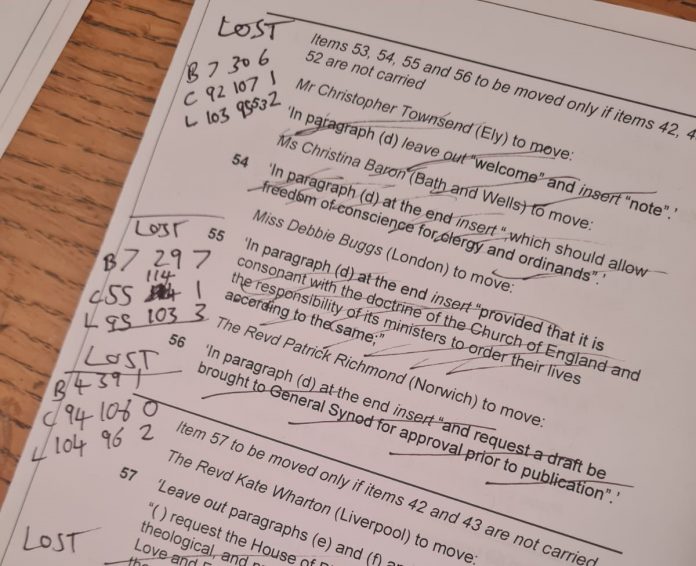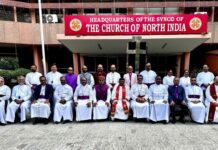On Wednesday afternoon more than eighteen thousand people tuned into the livestream of General Synod.
If you were one of those eighteen thousand people and you spent most of the time just trying to work out what on earth was going on – you were not alone.
If you were one of those eighteen thousand people and you didn’t really understand what the outcome was – you were not alone.
This blog gives a brief summary of what has happened and a suggestion of the significance of the results so far. It then set out a little bit of how Synod made the decisions it did – to help you follow things more easily if you plan to watch the rest of the debate this morning – starting at 9.15am.
What happened?
The Bishop of London brought a motion to General Synod on behalf of all the bishops – setting out seven things about their response to the Living in Love and Faith process which they hoped that Synod would affirm (You can find the Order Paper which has the motion and amendments on it for Wed afternoon here).
After some initial speeches (by The Archbishop of Canterbury, Vaughan Roberts, the Bishop of Oxford and Jill Duff, the Bishop of Lancaster) which gave a flavour of the main arguments for and against the motion, Synod began to get into the nuts and bolts of amendments.
Because very few people are happy with the bishops’ plan there were 28 amendments tabled for debate. Each amendment was taken in turn.
Over five hours, 19 of the amendments were considered – the rest will be dealt with on Thursday morning starting at 9.15am.
In three cases, the person who had tabled the motion decided not to put it – so the amendment was ignored.
In four cases, there was not enough support for a debate – so the amendment was ignored.
The remaining twelve were debated one after the other. In each case a number of people spoke in favour and a number of people spoke against and eventually Synod voted on whether to keep the amendment or bin it.
In all but one case, Synod chose to vote by Houses – so the bishops, clergy and laity voted separately using their electronic voting cards. For an amendment to carry, more than 50% of each house had to vote in favour of it.
Here is my record of the voting results (please correct if I’ve misheard any of the figures)

All the amendments put so far have failed – on Thursday morning there will be a chance to debate the other nine, but it is unlikely any amendments will gain a majority in all three houses.
What is the significance of the votes (so far)?
The majority of bishops voted against all the amendments – suggesting that for the most part they are committed to the approach they have taken.
It appears that up to 15 bishops are prepared to make some kind of stand for orthodoxy – but we will have to wait and see how they vote on the main motion to see how much of a stand that might be.
While the bishops are so united it will be hard for any amendment or motion to pass which does not follow the bishops’ lead.
It is difficult to tell exactly what is going on in the House of Laity and House of Clergy – suffice to say they are both divided – and neither the orthodox nor the revisionists have an overwhelming majority. Once the lists of how people voted are published it will be easier to see how many ‘floating voters’ there are.
The amendment which sought to remove the paragraph which welcomed the bishops’ decision to commend and issue Prayers of Love and Faith probably tells us much of what we need to know – in many ways this was the key question – with orthodox members voting in favour (against the prayers) and revisionists voting against (for the prayers).
Two speeches given during this part of the debate, perhaps highlight the two gospels on offer at General Synod – you can watch them here:
Benjamin John gave a clear gospel presentation, transformation and pleaded with the bishops to repent.
Graham Kirk-Spriggs explained the alternative ‘good news’ – that he deserves to be able to marry his boyfriend – and he does not deserve the indignity of being excluded for loving ‘in a different way.’
The voting shows the revisionists are able to gain a simple majority of both clergy and laity votes. This means that the bishops need their support for any ‘normal’ vote in the future.
However, the orthodox appear to be able to muster more than a third of votes in both the House of Clergy and House of Laity – which means they have a blocking minority IF there is a vote on a matter of doctrine or liturgy. In that situation the bishops would need to work hard to get the support of the orthodox (or their willingness to abstain).
What happens next?
General Synod will reconvene at 9.15am.
Once all nine of the remaining amendments have been debated, the Synod will debate the motion (including any amendments that have passed) as a whole.
The Bishop of London will then be given an opportunity to respond to the debate and then here will be a final vote on that. It is likely that that vote will be by Houses.
That is likely to take most of the morning session.
The irony is – after eight or nine hours of debate the General Synod will not really have decided anything. The Bishops can still do as they see fit with their proposal, having said they do so, having ‘listened to Synod.
There will be a further blog exploring what the Bishops might do after we see the results of the final vote.
Ten Steps To a Synod Vote – A quick guide to the procedures
Each amendment had to be taken in turn – following this process to determine whether the amendment was ‘carried’ or was ‘lost’:
1) Someone has to propose or put the motion
2) The Bishop of London made a speech saying whether she would accept the amendment or oppose it
3) 25 people have to stand up to say they want to debate the amendment
4) Speeches are made for and against the amendment. (People jump to their feet to be called to speak by the Chair)
5) After a while someone makes a ‘motion for closure’ – which indicates they think enough speeches have taken place.
6) If the ‘motion for closure’ is carried then Synod decide how to vote – there are three main ways:
a. A show of hands (which if it is close can become a count of Synod)
b. A count of Synod (voting is done electronically and the names of who voted each way will be published in a week or so.)
c. A count by Houses (voting is done electronically and the names of who voted each way will be published in a week or so.) Synod has three Houses – the bishops, the clergy and the laity.
The vote has to be won by a simple majority in all three houses if it is to be carried.
7) If an amendment is carried the motion is amended – if not the amendment falls and is ignored.
8) Once all the amendments have been taken there is the opportunity to debate the amended motion.
9) Again, after a motion for closure is carried, the Person proposing the motion has the opportunity to make a closing speech.
10) And finally there is a vote on the amended motion using one of the methods outlined above.
It is possible that at some point someone will jump to their feet and ask for ‘a move to next business’ – this is a procedural motion – and if, after following steps 2-6 above the Synod passes that motion – then everything stops – the debate on the motion is considered to be ‘finished for now’ and a final vote never takes place.










